Excerpts from Jim Conrad's
Naturalist Newsletter
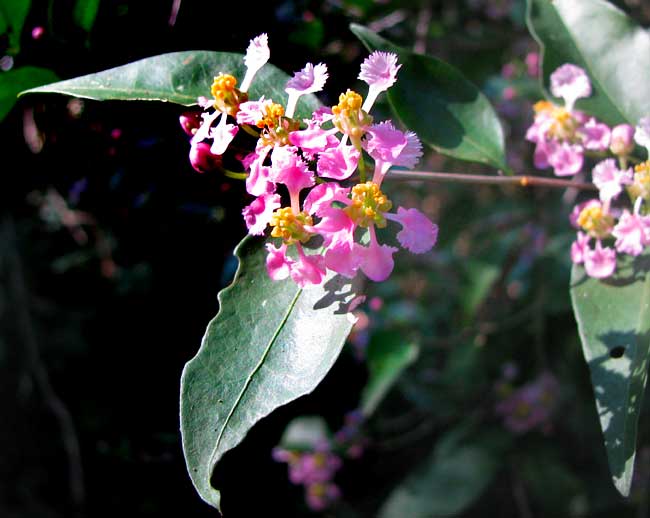
from the November 22, 2009 Newsletter issued from Hacienda Chichen Resort beside Chichén Itzá Ruins, central Yucatán, MÉXICO; limestone bedrock, elevation ~39m (~128ft), ~N18.52°, ~W95.15°
"WILD CRAPE-MYRTLE"
If you're familiar with the North's Crape-Myrtle, whose pink, frilly-petaled blossoms are shown at www.backyardnature.net/n/w/crape-my.htm you'd have no problem with the name "Wild Crape-Myrtle" for the small, flowering tree shown above.
Despite all the similarities between the flowers in the picture and flowers of the northern Crape-Myrtle, the two plants belong to different families. Our currently flowering little tree is best known in English literature as Barbados-Cherry, though it's not in the cherry's family either; sometimes it's also called Acerola. It's MALPIGHIA GLABRA, a member of the tropical and subtropical Malpighia Family, the Malpighiaceae. In most of North America there are no wild members of the Malpighia Family.
Members of the Malpighia Family are woody with simple, usually opposite leaves. Flowers typically have five sepals, five petals, and the petals are usually slightly different in size, fringed or toothed, and somewhat spatula-shaped -- narrowing at the base into a slender "stem" or claw. Stamens or sterile, stamen- like "staminodia" usually number ten. A blossom close- up of our plant showing these features is below:
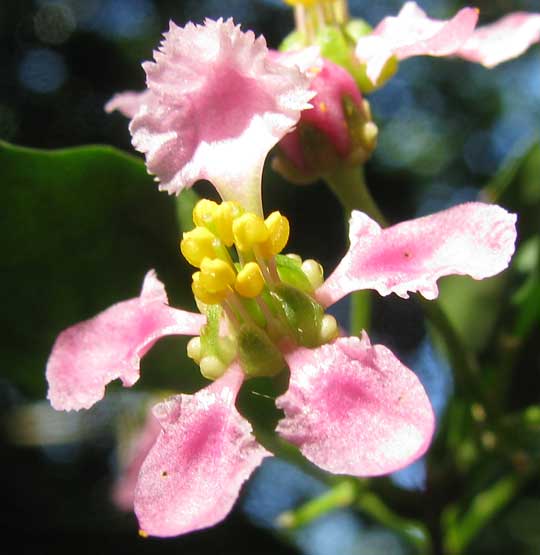
The most distinguishing feature, though, is what appears in the above photo between the petals' claws. Especially in the bottom, left corner of the picture, do you see those two cream-colored bumps between the two petals' claws? A close-up side-view of the bumps is shown below:
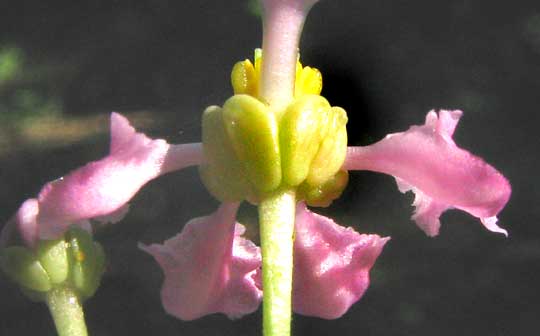
Each of those egg-shaped items is a gland, two to a sepal, the sepal being one of a calyx's five triangular or toothlike divisions, the calyx being the greenish "cup" subtending the other flower parts. In this picture the glands completely obscure the calyx. More typically, on other species, the glands look like two small warts at the base of each sepal. Whatever the size or shape of these glands, when you see two of them at the base of each of a flower's sepals, just think "Malpighia Family." It's unusual to have such a dependable field mark for recognizing plant families, so if you like identifying tropical plants, this is a trick worth keeping in mind. I'm not sure what the glands are for. Often glands secrete substances that attract or repel insects.
Often you see Barbados-Cherries growing around traditional Maya houses because the trees produce a thin-skinned, acid fruit that's good to eat. The fruit contains 32 times more Vitamin C than a similar quantity of orange juice. When eleven fruit pulps were tested, that of Barbados-Cherry scored the highest anti-oxidant potency.
No fruits are available here now, though, just the pretty blossoms on somewhat spindly, 10-ft-tall trees spread somewhat evenly and commonly throughout the forest understory all around us.
Barbados-Cherries grow from southern Texas through our area all the way to northern South America.
from the May 16, 2010 Newsletter issued from Hacienda Chichen Resort beside Chichén Itzá Ruins, central Yucatán, MÉXICO; limestone bedrock, elevation ~39m (~128ft), ~N18.52°, ~W95.15°
BARBADOS CHERRIES RIPE
Nowadays the Barbados Cherries are heavy with crimson fruits, looking very much like 15-ft-tall crabapples up North. Even the trees' leaves, much-branching stems and flaky trunk look like those of crabapple. You can see a handsome branch of them below:
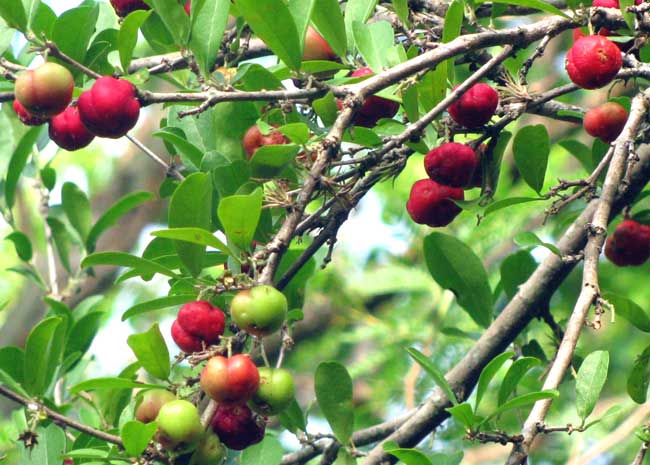
The fruits, which are three-seeded drupes, are about half an inch across, are fleshier than crabapples, and better tasting -- a little like overripe apple, maybe. The main problem with ours is that every one I bite into is wormy. That's a shame because the drupes are produced in abundance and they're so tasty that one wants to just gorge on them, whole mouthfuls at a time; having to remove the worms slows things down.
Earlier when we looked at the flowers we made much ado about the large, yellow pairs of glands attached to the back of each flower's sepal. Brown, dried-up, gland-bearing sepals still subtend the current drupes, as shown below:
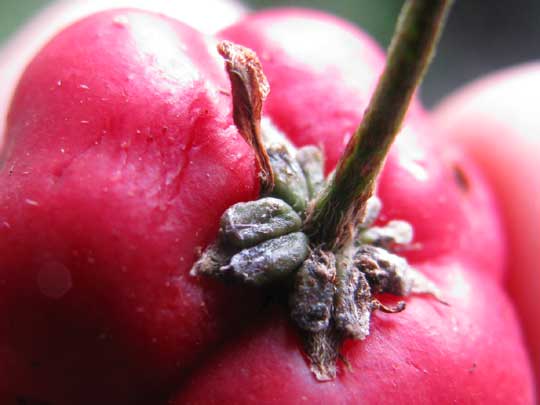
from the July 12, 2015 Newsletter issued from Río Lagartos, on the Yucatan Peninsula's northern coast (~N21.60°, ~W88.16°), Yucatán state, MÉXICO
SHRUB BARBADOS CHERRIES
Last week when my computer crashed I lost nice pictures of a shoulder-high tree that's common here in thin soil atop limestone. The trees were as loaded with bright crimson, cherry-sized fruits as up North an orchard's most prolific cherry tree can be laden with cherries. This week most of the fruits are gone, but a few aged, puckered ones still can be found on certain shrubs' gray branches, as shown below:
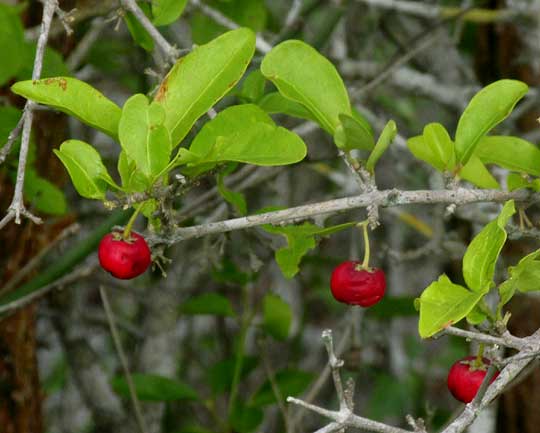
Several fruits, with one open to show the small, soft, whitish seeds embedded in its pulp, are shown below:
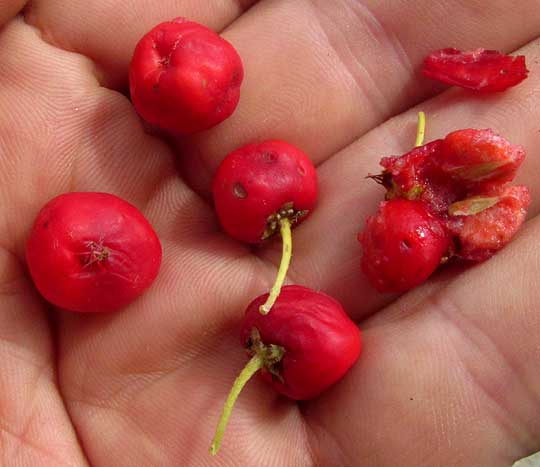
Even though now these fruits are passed their prime, they're sweet and tasty. The seeds are so small and soft that they can be chewed and swallowed.
In rainier areas farther south where the forest is much higher and lusher we've seen fruits like this on regular-sized trees, which we identified as Barbados Cherries, Malpighia glabra. {above section}.
In contrast to those trees, here in our arid zone in thin soil atop limestone, our plants are little more than much-branching shrubs. Six Malpighia species are listed for the Yucatan Peninsula, so could this be one of those other five species?
It seems that our plants are the same as the tree species we've enjoyed so much farther south, just that here with less rainfall and thinner soil they make shrubs, not fair-sized trees.
While wrestling with the name situation I learned just how confused and confusing the Barbados Cherry's taxonomy is. Specifically, many experts lump together two of the six species recognized by the Yucatan's botanists, our M. glabra and M. emarginata, while others keep them separate. The Encyclopedia of Life people at EOL.Org separate them, regarding M. emarginata as the cultivated species (known commercially as the Acerola) and M. glabra as the wild one. They also say that M. glabra has smaller and more pointed leaves than M. emarginata, but I can't see much difference.
Whatever we call the species producing these excellent little fruits, they're wonderful to nibble on as you wander the marshlands at the mangroves' edge. Fruits on trees in the rainier areas farther south often are occupied by worms, but that's less of a problem in our arid area. This is a fine tree, native to southern Mexico, through Central America deep into South America, plus it's so desirable that it's grown as far north as Texas, and in subtropical parts of Asia, particularly India.